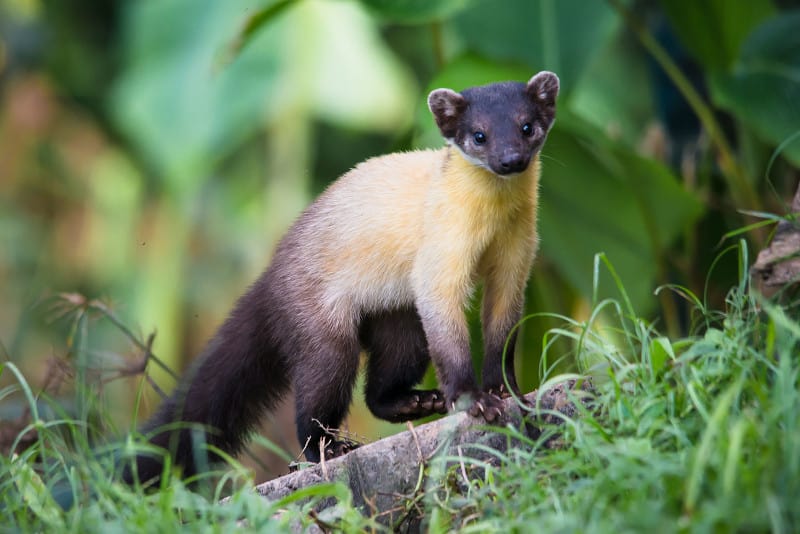Yellow Throated Marten Facts
- For reasons that appear readily apparent, this colorful creature most frequently goes by the common name of the Yellow Throated Marten. That’s the english language term for the mammal, though. It’s also known by the names of kharza and chuthraul.
- Professional scientists, however, such as researchers, tend to use the official scientific name for the animal when referring to it. Fortunately, it’s a comparatively simple term, as such go. That’s because its formal name in technical circles is Martes flavigula.
- The first recorded recognition of the intriguing creature as a separate and distinct species, though, occurred back in 1785. The Dutch naturalist and physician, Pieter Boddaert, holds the distinction of achieving this noteworthy accomplishment.
- Regardless of which term one chooses to employ, though, it’s a truly remarkable and visually impressive species. It also holds yet another distinction. That’s due to the fact that it constitutes the largest known variety of marten in its native habitation range.
- Fortunately, the Yellow Throated Marten appears to be maintaining a population base that’s both sufficient and stable. This also seems to hold true throughout the entirety of its natural range. The IUCN, therefore, list it as Least Concern on its Red List.
- The remarkable creation of Nature nevertheless faces several potential threats to its existence, at least. Habitat loss understandably forms a possible danger, due to the expansion of man. Climate change, however, also poses a potential threat to it.
Related Articles
Yellow Throated Marten Physical Description
It bears noting that the gorgeous Yellow Throated Marten deserves appreciation for characteristics other than its sheer visual appeal. That trait, however, nevertheless merits its own attention and mention, of course. It’s also an impressively large variety of marten.
Like many other mammals, though, it displays a moderate degree of the physiological characteristic of sexual dimorphism. In its specific case, however, this gender based difference manifests in terms of physical size, not overall appearance of the animal.
More specifically, the males of the species typically attain a greater size than their female counterparts. This tendency follows the more common pattern among mammals, inlcuding the other known species of marten. Moreover, this includes both weight and length.
Weights, however, frequently vary quite significantly, typically due to various local environmental factors. Males generally reach an average weight that ranges from roughly 5.5 – 12. 6 lb (2.5 – 5.7 kg). Females, though, only average about 3.5 – 8.4 lb (1.6 – 3.8 kg).
Males of the species also average about 19.7 – 28.3 in (50 – 72 cm) in terms of body length. Their female counterparts, meanwhile, reach average lengths of around 20 – 24 in (50 – 62 cm). The tail also grows to as much as 65% of the length of the body.
It’s the color pattern of the aptly-named Yellow Throated Marten that garners the most attention, though. Much of the body and neck develop the stunning yellw hue. The elongated face, legs, and tail, meanwhile, generally display a black or dark brown shade.
- Kingdom: Animalia
- Phylum: Chordata
- Class: Mammalia
- Order: Carnivora
- Family: Mustelidae
- Genus: Martes
- Species: M. flavigula
Yellow Throated Marten Distribution, Habitat, and Ecology
Fortunately, both for the Yellow Throated Marten itself, and those of us who appreciate Nature, it evolved as native to a moderately broad swathe of the globe. That’s due to the fact that this marvel of evolutionary processes evolved as native to part of Asia.
Moe precisely, though, this fascinating mammal appears to inhabit a broad section of the southern portion of that remarkable continent. There, it appears in such countries as Pakistan, Afghanistan, India, Bhutan, Nepal, China, and Taiwan, to name a few.
The animal also evolved as highly flexible in its choice of habitat. That trait, in fact, continues to serve it well. Due to this versatility, it appears in a wide range of ecosystems. These include such regions as lowland swamps, alpine meadows, and forests.
Along with this pattern of habitation comes an impressive adaptability to altitudes as well as other, related conditions. In some portions of its range, including Nepal, it lives at truly impressive altitudes. There, some individuals appear at up to 14,800 ft (4,510 m)!
Though primarily carnivorous, it occasionally supplements its diet with small quantities of plant matter, such as fruit and nectar. It mainly feeds on various animal prey, though. That prey generally consists of smaller creatures, such as lizards, snakes, and mice.
The Yellow Throated Marten typically hunts as a diurnal animal, and further most often does so in pairs. Hunting parties of three or more sometimes form, however. It also feeds opportunistically on carrion, often consuming the leavings of larger hunters, like tigers.
Species Sharing Its Range
Check out our other articles on 3 Terrific Freshwater Turtles, Greater blue-ringed octopus, Lake Hillier, Blue Footed Booby, Ascension Island Parsley Fern, Giant Girdled Lizard

